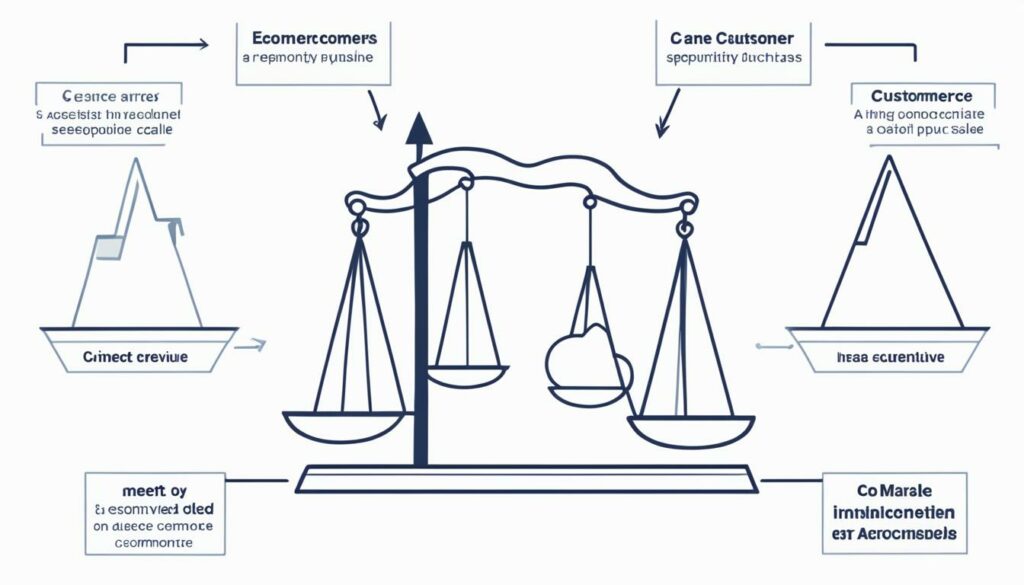Welcome to the world of double-entry accounting, a fundamental system that ensures financial accuracy in the realm of ecommerce. As an essential part of any accounting system, double-entry accounting, also known as double-entry bookkeeping, involves recording each financial transaction twice to maintain the balance and integrity of the business’s financial records.
When a transaction occurs, two entries are made in the ledger accounts: one for the source of money (debit) and another for the destination of money (credit). The beauty of double-entry accounting lies in the balancing act. Both sides of the ledger must mathematically equal, with the total debits equaling the total credits. This meticulous process guarantees an accurate representation of the business’s financial state by accounting for every dollar that comes in and goes out.
Double-entry accounting is a cornerstone of financial management, allowing businesses to create various accounts to track money receivable, payable, and inventory. It plays a crucial role in preparing financial statements, complying with accounting principles, and facilitating decision-making processes. The accounting equation Assets = Liabilities + Equity serves as the foundation for double-entry accounting, ensuring the balance and integrity of a business’s financial records.
Key Takeaways:
- Double-entry accounting records each financial transaction twice to maintain accuracy and balance in a business’s financial records.
- It involves making entries in the ledger accounts as debits and credits, ensuring that the two columns balance.
- Double-entry accounting allows businesses to create various accounts to track money receivable, payable, and inventory.
- It is essential for preparing financial statements, complying with accounting principles, and making informed business decisions.
- The accounting equation Assets = Liabilities + Equity forms the basis of double-entry accounting, ensuring financial accuracy.
The Importance of Double-Entry Accounting in Ecommerce
Double-entry accounting is crucial for managing ecommerce business finances with unparalleled precision and control. It plays a significant role in providing a clear and accurate understanding of a business’s financial position and performance.
By recording each transaction twice, double-entry accounting ensures financial accuracy and enables the detection of errors or fraud. This meticulous approach to accounting allows businesses to prepare comprehensive financial statements, including the balance sheet, income statement, and cash-flow statement, which provide valuable insights into the financial health of the business.
Accurate financial statements are essential for making informed business decisions and attracting potential lenders or investors. Double-entry accounting not only helps maintain financial accuracy but also aids in preventing and detecting fraudulent activities. The balancing of accounts enables the identification of any discrepancies or anomalies that may indicate fraudulent behavior.
With the rising prevalence of ecommerce, the importance of double-entry accounting cannot be overstated. The dynamic nature of online business operations and the vast number of transactions require a robust accounting system that can handle the complexity of ecommerce finances.
By implementing double-entry accounting practices, ecommerce businesses can effectively track their financial performance, analyze trends, and make data-driven decisions to enhance business operations. It provides a comprehensive understanding of the revenue and expenses of the business, allowing for better resource allocation and strategic planning.
Furthermore, double-entry accounting serves as the foundation for evaluating the overall business performance and identifying areas for improvement. By assessing key financial indicators and ratios derived from double-entry accounting records, such as profitability ratios, liquidity ratios, and operating efficiency ratios, ecommerce businesses can gain valuable insights into their financial performance and take appropriate measures to optimize their operations.
“Accurate financial statements are essential for making informed business decisions and attracting potential lenders or investors.”
Sample Table – Financial Ratios Derived from Double-Entry Accounting
| Financial Ratio | Calculation | Relevance |
|---|---|---|
| Profit Margin | Net Income / Revenue | Measures the profitability of the business. |
| Return on Assets (ROA) | Net Income / Total Assets | Assesses the efficiency of asset utilization. |
| Current Ratio | Current Assets / Current Liabilities | Evaluates the liquidity and short-term solvency of the business. |
| Inventory Turnover | Cost of Goods Sold / Average Inventory | Indicates the efficiency of inventory management. |
By analyzing these financial ratios alongside the double-entry accounting records, ecommerce businesses can gain valuable insights into their financial stability, growth potential, and operational efficiency.
In summary, double-entry accounting is paramount to the success of ecommerce businesses. It ensures financial accuracy, aids in fraud prevention, enables the preparation of accurate financial statements, and provides valuable insights for business management and decision-making. Implementing robust double-entry accounting practices helps ecommerce businesses navigate the complexities of financial management and enhances their overall financial performance.

Strategies to Improve Double-Entry Accounting in Ecommerce
To enhance double-entry accounting in ecommerce, businesses can implement various strategies that streamline processes and enhance accuracy. These strategies include:
- Automate Accounting Processes: Utilize accounting software to automate repetitive tasks and reduce the chances of errors. Accounting software often provides features such as a general ledger, accounts receivable and payable functionality, and automated checks and balances. This automation streamlines the recording and reconciliation of transactions, improving efficiency and accuracy.
- Hire a Bookkeeper or Accountant: Consider employing a qualified bookkeeper or accountant with expertise in double-entry accounting. Their knowledge and experience can ensure proper record-keeping, financial reporting, and adherence to accounting principles. Engaging a professional also reduces the burden on business owners, allowing them to focus on core operations.
- Set Up a Chart of Accounts: Establish a well-structured chart of accounts to organize transactions and maintain proper categorization of financial entries. A chart of accounts provides a systematic framework for recording and classifying assets, liabilities, equity, income, and expenses. This helps ensure consistency, transparency, and ease of analysis when generating financial reports.
By implementing these strategies, businesses can significantly improve their double-entry accounting processes, leading to increased financial accuracy, streamlined operations, and enhanced decision-making capabilities.
Example of a Chart of Accounts:
Customer Behavior and Double-Entry Accounting in Ecommerce
Double-entry accounting in ecommerce not only ensures accurate financial records but also provides valuable insights into customer behavior. By analyzing the flow of money through the business, we can gain a better understanding of customer purchase patterns, sales trends, and inventory management. The data recorded through double-entry accounting allows us to identify popular products, track sales trends over time, and observe seasonal variations in customer behavior. This information is incredibly valuable for making data-driven decisions and optimizing various aspects of our ecommerce business.
Identifying Customer Purchase Patterns
Through double-entry accounting, we can track individual ecommerce transactions and analyze the purchasing behavior of our customers. By examining the frequency of purchases, types of products purchased, and average transaction values, we can identify patterns that help us understand our customers’ preferences. For example, we may notice that certain products are frequently bought together, indicating the potential for cross-selling or bundling strategies. Understanding customer purchase patterns allows us to tailor our marketing efforts and product offerings to better meet their needs.
Analyzing Sales Trends
Double-entry accounting provides us with a detailed record of our sales transactions, allowing us to analyze sales trends. By examining the data over different time periods, we can identify fluctuations in sales volume and revenue. This analysis helps us understand the factors that influence our sales performance, such as seasonal variations or the success of marketing campaigns. With this information, we can make informed decisions to optimize our sales strategies and allocate resources effectively.
“Analyzing customer behavior through double-entry accounting allows us to make informed decisions and optimize various aspects of our ecommerce business.”
Optimizing Inventory Management
Double-entry accounting also provides insights into inventory management. By tracking the outflow of inventory as recorded in our accounting records, we can gain a better understanding of product demand and adjust our inventory levels accordingly. This enables us to avoid stockouts or overstock situations, ensuring that we have the right products at the right time. Effective inventory management improves customer satisfaction by minimizing delays in order fulfillment and reducing carrying costs.
Overall, double-entry accounting in ecommerce goes beyond financial accuracy and offers valuable insights into customer behavior. By utilizing the data recorded through double-entry accounting, we can identify customer purchase patterns, analyze sales trends, and optimize our inventory management strategies. These insights empower us to make data-driven decisions and enhance the success of our ecommerce business.

Double-Entry Accounting and its Relation to Other Metrics in Ecommerce
Double-entry accounting serves as a fundamental component of financial management in ecommerce businesses. But, its relevance extends beyond accurate record-keeping. Deciphering the data recorded through double-entry accounting allows businesses to calculate essential financial ratios, enabling informed decision-making and comprehensive assessment of their financial health and operational efficiency.
Profitability ratios provide insights into a business’s ability to generate profits relative to its revenues, expenses, and investments. By analyzing income and expense accounts in double-entry accounting, businesses can calculate crucial ratios such as gross profit margin and net profit margin. These ratios measure a business’s profitability and determine its financial feasibility and long-term sustainability.
For ecommerce businesses, understanding profitability ratios is vital to identify lucrative product lines, optimize pricing strategies, and evaluate the overall effectiveness of business operations.
On the other hand, liquidity ratios assess a business’s ability to meet short-term obligations and demonstrate financial stability. These ratios can be derived from balance sheet accounts recorded in double-entry accounting. Ratios like the current ratio and quick ratio measure a business’s liquidity and determine its capacity to address immediate financial needs and seize growth opportunities.
Solvency ratios focus on a business’s long-term financial sustainability and its ability to repay debts and obligations. By analyzing the equity and liability accounts in double-entry accounting, businesses can calculate ratios such as the debt-to-equity ratio and interest coverage ratio. These ratios provide insights into the overall financial soundness of the business and its capacity to fulfill long-term commitments.
Accurate solvency ratios obtained through double-entry accounting aid businesses in managing their capital structure, making sound financial decisions, and attracting potential investors.
Operating efficiency ratios, derived from double-entry accounting, measure how efficiently a business utilizes its assets and resources to generate revenues. These ratios, such as the asset turnover ratio and inventory turnover ratio, enable businesses to identify operational bottlenecks and make informed decisions to enhance efficiency and optimize resource allocation.
The analysis of operating efficiency ratios based on double-entry accounting data equips businesses with valuable insights to streamline operations, eliminate inefficiencies, and improve overall performance.
By combining these financial ratios with the data recorded and maintained through double-entry accounting, ecommerce businesses gain a comprehensive understanding of their financial position, growth potential, and competitive standing. This integrated approach empowers businesses to make data-driven decisions, optimize financial strategies, and strategize for sustainable growth.
Challenges and Considerations in Double-Entry Accounting for Ecommerce
While double-entry accounting offers numerous benefits, there are some challenges and considerations for ecommerce businesses. The complexity of double-entry accounting, especially when dealing with multiple accounts and accounting principles, can be overwhelming for small businesses without accounting expertise. It can also be time-consuming to maintain a ledger and review account balances regularly.
Very small businesses may struggle with the cost of hiring a bookkeeper or accountant or investing in accounting software. Accounting errors can occur if proper attention is not paid to recording transactions accurately. Therefore, it is essential to select suitable accounting software that meets the specific needs of the ecommerce business and ensures reliable record-keeping.

| Challenges | Considerations |
|---|---|
| Complexity of double-entry accounting | Proper training and expertise needed |
| Time-consuming nature | Regular review and maintenance |
| Cost implications | Alternative options for small businesses |
| Potential for accounting errors | Accurate recording of transactions |
| Software selection | Choosing the right accounting software |
Conclusion
In conclusion, double-entry accounting is an essential tool for ecommerce businesses in managing their finances effectively. By recording each transaction twice, businesses can ensure financial accuracy and gain a comprehensive view of their financial position. The use of double-entry accounting enables businesses to make informed decisions, track customer behavior, and assess their financial performance.
Despite the challenges associated with implementing and maintaining double-entry accounting, the benefits it provides far outweigh the difficulties. Ecommerce businesses should prioritize the use of double-entry accounting to maintain financial accuracy, enhance business management, and support effective decision-making.
Double-entry accounting serves as the foundation for financial accuracy and transparency, allowing businesses to have a clear understanding of their financial health. With accurate and reliable financial records, ecommerce businesses can analyze their revenue, expenses, and profit margins, enabling them to make informed decisions regarding pricing strategies, inventory management, and business growth.
FAQ
What is double-entry accounting?
Double-entry accounting, also known as double-entry bookkeeping, is a system of recording each business transaction twice. It involves making two entries – one for the source of money and another for the destination of money. These entries are recorded in debits (left-side) and credits (right-side) columns in a ledger.
Why is double-entry accounting important in ecommerce?
Double-entry accounting is vital for managing ecommerce business finances with unmatched precision and control. It provides a clear and accurate picture of a business’s financial position and performance. By recording transactions twice, it helps in maintaining financial accuracy and detecting errors or fraud. Double-entry accounting also allows businesses to prepare financial statements, such as the balance sheet, income statement, and cash-flow statement, which provide valuable insights into the financial health of the business.
What strategies can improve double-entry accounting in ecommerce?
To improve double-entry accounting in ecommerce, businesses can consider using accounting software to streamline and automate accounting processes. Hiring a bookkeeper or accountant with expertise in double-entry accounting can ensure accurate record-keeping and financial reporting. Setting up a chart of accounts is crucial for organizing transactions and maintaining proper categorization of financial entries.
How does double-entry accounting provide insights into customer behavior?
By analyzing the flow of money through the business, double-entry accounting can provide insights into customer purchase patterns, sales trends, and inventory management. This information can be used to make data-driven decisions, such as adjusting inventory levels, targeting specific customer segments, and optimizing pricing strategies.
How is double-entry accounting related to other metrics in ecommerce?
Double-entry accounting is closely related to other metrics in ecommerce, such as profitability, liquidity, solvency, and operating efficiency. Financial ratios can be calculated using the data recorded through double-entry accounting, providing insights into a business’s financial health and performance.
What are the challenges and considerations in double-entry accounting for ecommerce?
While double-entry accounting offers numerous benefits, there are challenges associated with implementing and maintaining it. The complexity of double-entry accounting can be overwhelming for small businesses without accounting expertise. It can also be time-consuming to maintain a ledger and review account balances regularly. Very small businesses may struggle with the cost of hiring a bookkeeper or accountant or investing in accounting software. Accounting errors can occur if proper attention is not paid to recording transactions accurately. Therefore, it is essential to select suitable accounting software that meets the specific needs of the ecommerce business and ensures reliable record-keeping.
